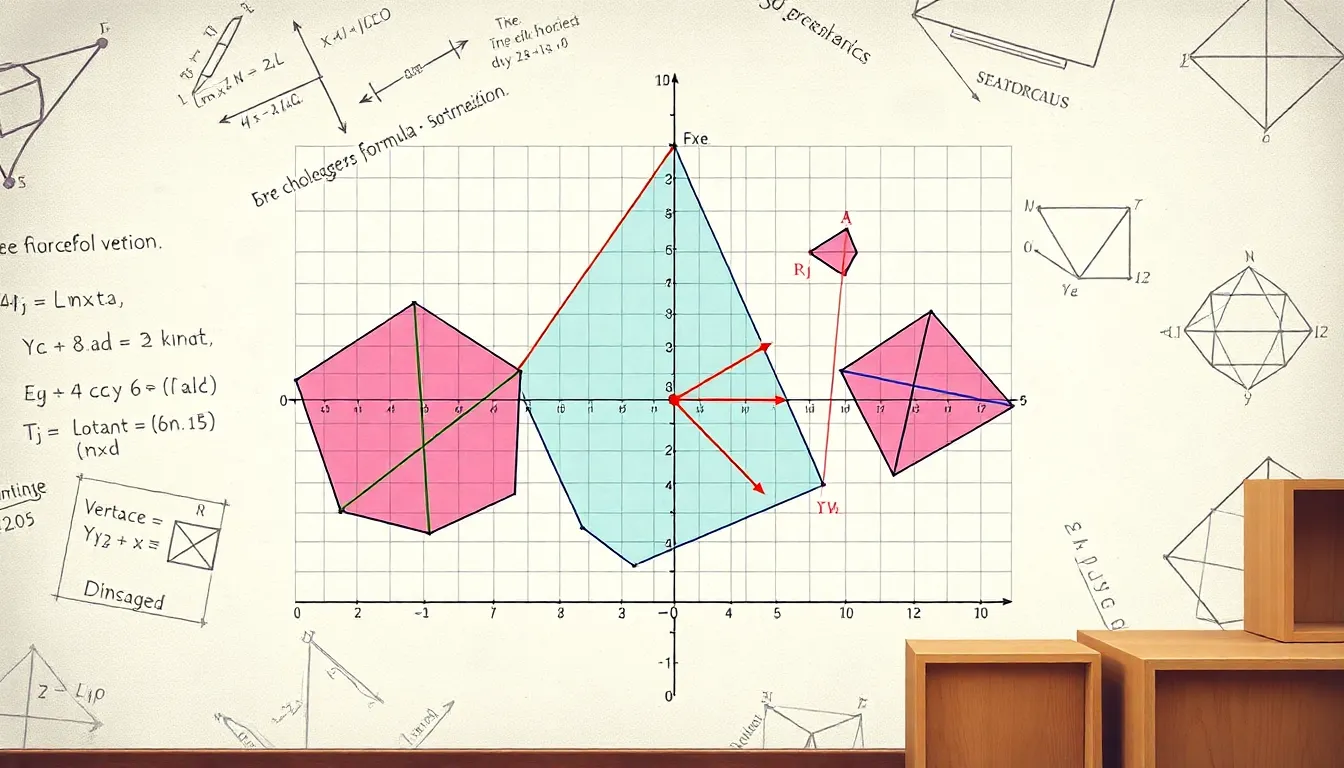Finding the area of a polygon might sound like a task for math wizards or geometry nerds, but it’s easier than it seems. Whether you’re trying to calculate the space for a new garden or just impressing your friends with your mathematical prowess, mastering this skill can make you the superstar of any DIY project.
Table of Contents
ToggleUnderstanding Polygons
Polygons are fundamental shapes in geometry with distinct characteristics. Recognizing these characteristics assists in calculating their area effectively.
Definition of a Polygon
A polygon consists of a closed shape with straight sides. Each side connects at vertices, forming angles. Common examples include triangles, quadrilaterals, and hexagons. In a polygon, the number of sides defines its classification. Simple polygons have non-intersecting sides, while complex polygons feature intersecting sides.
Types of Polygons
Polygons are categorized by their sides and angles. Triangles possess three sides and three angles, while quadrilaterals have four sides and four angles. Regular polygons, like squares and equilateral triangles, feature equal-length sides and equal angles. Irregular polygons display varied side lengths and angles. Key types include pentagons with five sides, hexagons with six, and octagons with eight, each serving unique geometric properties.
Methods to Find Area of Polygon

Finding the area of a polygon can involve several techniques, each suitable for different types of shapes.
Using the Shoelace Formula
The Shoelace formula provides an effective method for calculating the area of a polygon based on its vertex coordinates. To apply this formula, list the coordinates sequentially, ensuring to return to the starting point. Next, multiply each x-coordinate by the following y-coordinate and vice versa. After obtaining these products, sum them together and take the absolute value of the result, finally dividing by two. This straightforward approach enables quick calculations for polygons defined in a coordinate system.
Decomposing into Triangles
Decomposing a polygon into triangles offers another reliable technique for area calculation. Begin by drawing diagonals from one vertex to all non-adjacent vertices. Each triangle formed can be treated separately. Once the individual areas of these triangles are calculated—using the formula ( text{Area} = 0.5 times text{base} times text{height} )—add them together to find the total area of the polygon. This method effectively simplifies the problem and leverages the fundamental properties of triangles.
Using Coordinates in a Cartesian Plane
Using coordinates in a Cartesian plane presents a systematic way to find a polygon’s area. Each vertex is plotted on the coordinate grid, allowing for precise measurement. By applying the aforementioned Shoelace formula or triangle decomposition, the area can be derived from the coordinates. This technique is especially useful for more complex shapes, where precise calculations are necessary. Utilizing coordinates gives a clear advantage in accuracy for mathematical applications.
Tools and Resources
Various tools and resources simplify the process of finding the area of polygons. These include online calculators and geometry software.
Online Area Calculators
Online area calculators provide a quick way to determine the area of polygons. Users can input dimensions, and the calculator performs the necessary computations instantly. Several reputable websites offer polygon calculators that handle various shapes, including triangles, quadrilaterals, and hexagons. Some calculators even allow for inputting vertex coordinates to automatically calculate the area using formulas like the Shoelace formula. Websites such as Calculator Soup and MathisFun are helpful resources for these calculations. By utilizing these tools, individuals can save time and reduce the chances of errors in their calculations.
Geometry Software
Geometry software enhances the experience of calculating polygon areas. Programs like GeoGebra and Cabri Geometry provide users with interactive platforms to explore polygon properties visually. Through these applications, individuals can draw polygons and manipulate vertices, enabling precise area calculations. The software often comes equipped with tools for measuring and area estimation for any complex shape. Users can also save their work and revisit calculations later, promoting convenience and efficiency. By leveraging these advanced tools, it becomes easier to enhance understanding and accuracy in geometry.
Common Mistakes to Avoid
Understanding the common pitfalls when calculating the area of a polygon can enhance accuracy. Recognizing these mistakes helps in achieving better results.
Miscalculating Side Lengths
Miscalculating side lengths frequently leads to inaccurate area calculations. Remembering to measure each side precisely is crucial. Using a ruler or measuring tape ensures accurate dimensions. Double-checking values prevents simple errors from propagating. Many polygons require consistent side lengths, especially regular polygons. Deviating from accurate measurements impacts overall area calculations dramatically. Always verify that measurements correspond with the correct vertices when applying formulas. Failing to do so might result in significant discrepancies.
Ignoring Units of Measurement
Ignoring units of measurement is a common oversight that can confuse results. Consistent unit usage simplifies calculations. Whether using inches, centimeters, or meters, maintaining uniformity in all measurements is essential. Converting units when necessary prevents incorrect area assessments. For example, calculating area in square inches requires all dimensions in inches. Neglecting to denote units can lead to misunderstandings in interpretation. It’s beneficial to include units in every step of the calculation. Being mindful of units ensures clarity and accuracy in the final area results.
Finding the area of a polygon is an invaluable skill that opens doors to various practical applications. Whether planning a project or tackling a math problem understanding the different methods and tools available can make the process straightforward. By applying techniques like the Shoelace formula or decomposing shapes into triangles individuals can enhance their accuracy and efficiency.
Additionally using online calculators and geometry software provides quick and precise solutions. Being aware of common mistakes ensures more reliable results. With these strategies in hand anyone can confidently tackle the challenge of calculating polygon areas and improve their overall geometric skills.





